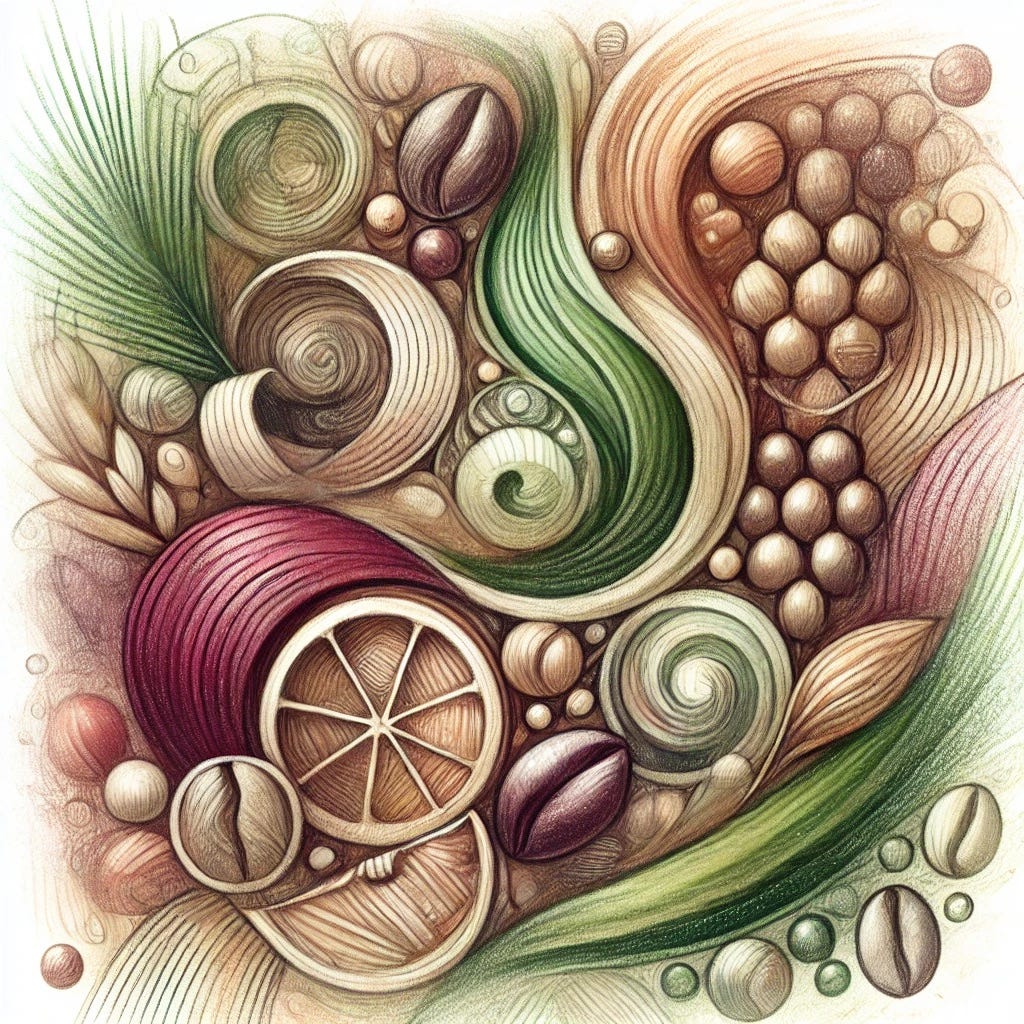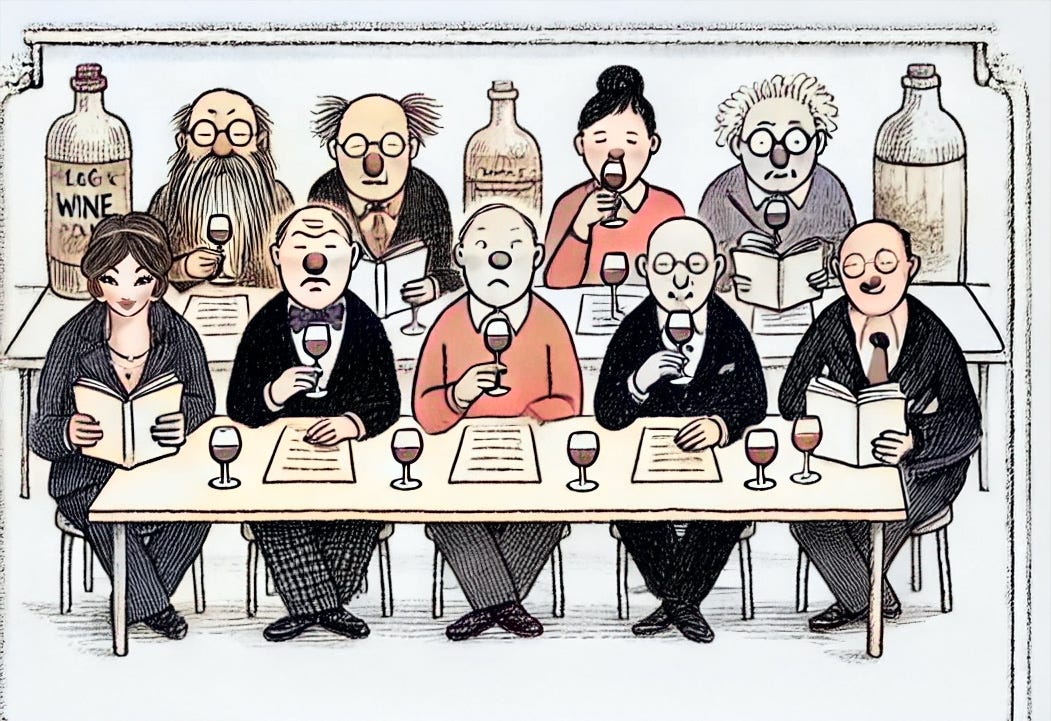NAPA VALLEY, Calif. — Most coffee drinkers know when they smell a freshly brewed cup what the aroma is. More serious coffee aficionados can easily differentiate between coffee, even terrible coffee, and products like Luzianne coffee (made with chicory) and Postum, a coffee-like beverage that’s a blend of wheat, wheat bran and molasses.
Serious coffee lovers would say that real coffee, which is made from roasted coffee beans, smells pretty much like, uh, coffee. Euphemistic phrases are not necessary. And that if handed a cup of Luzianne or Postum, they would come up with slightly different terms to describe their aromas. Close, but…
Likewise, cooks can identify the aromas of broccoli, green tea, olive oil and basil by simply naming the products. Although Brussels sprouts and cabbage may be confused, most people would describe them with veggie descriptors that may well be interchanged.
In almost every case, the aromas in these products come from chemicals that sensory scientists may identify with obscure and often extremely complex terminology, almost none of which have relevance to people without a chemistry degree.
The aromas in wine, too, are products of numerous different chemicals. In the distant past, serious wine lovers could identify many of the more distinctive varietal grapes (i.e., riesling, gewürztraminer, muscat) in two different ways. A good riesling should smell like riesling. The secondary way to describe these things is by the chemicals that produce them.
Less distinctive grape varieties are still relatively identifiable, especially to wine experts, by a set of common terms for each. Cabernets might be identified, first, as smelling like cabernet, and additional descriptors might include terms related to the wine’s endemic aroma traits and/or to a regional identity and/or how the wine was made (i.e. oak aging, lees contact).
Challenge your vocabulary with this week’s mystery word. Submit your answer in the poll, and check the bottom of the page for the correct answer.
For most Americans, including most dedicated wine lovers, that has pretty much changed because making wine today differs radically from how it was made 50 years ago. Most people who buy expensive Napa Valley cabernets today do not use specific terms to describe most wines. Mostly they use somewhat vague characteristics – terms like powerful, concentrated, intense and explosive.
Winemakers, wine chemists and others inside the wine industry describe almost all wines with far more specific terms, some of which come straight out of a chemistry textbook. Many such terms refer to spoilage elements. Some smells can be either good or bad depending on how concentrated or trivial they are. Some of these elements are specific to certain grape varieties and are rarely if ever found in other grapes.
Some aromas are common not to specific grapes but are the direct result of certain techniques that are used in the process of making wine. Other aromas relate to specific characteristics of how a wine was aged, such as what kind of barrels it was aged in or how it got its oak flavoring (French oak vs. American, heavy toast, oak chips).
The aromatics listed below are not universal or common. Some may be found in extremely light concentrations that are hard to detect, especially by newcomers to wine. Or they may be so concentrated that they become almost offensive. Sort of like perfume. A little might be attractive; too much may be overpoweringly repellant.
Probably the most controversial scent in wine today, especially among winemakers who make cabernet, is methoxypyrazine, which is almost always referred to simply as pyrazine (pie’-rah-zeen). It is primarily observed in red wines where it smells like green bell pepper and in too high a concentration can be overwhelming. But a trace of it is (most older cabernet lovers agree) essential for a cabernet to be authentic.
The reason it is controversial is that some newcomers to wine have been educated to dislike it intensely, in any strength. (Winemaker Clark Smith coined a term to refer to some winemakers who are so afraid of pyrazine that they are “pyra-noid.”) Yet historically, traces of pyrazine in red wines were always known to winemakers as being essential for a cabernet to smell like a cabernet. Without any pyrazine, a cabernet is not only atypical of a wine from that grape, but it is also unlikely to develop many secondary characteristics as it ages.
In the last 30 years or more, wineries and growers have devised various schemes to get rid of all traces of pyrazine. One technique is to harvest cabernet grapes extremely late in the season. However, such a tactic can add other negative characteristics, creating a red wine that is neither particularly cabernet-like nor age-worthy.
Additionally, pyrazine is available in a different form as part of the aromatic profile of some cold climate sauvignon blancs (such as those from New Zealand). When it is paired with additional aromatics, such as tropical fruits (i.e. passion fruit), sauvignon blanc aromas can be exotic and attractive.
As with pyrazine, numerous other smells are often attractive in smaller concentrations and seen as a detriment when they are too strong. Lovers of specific wines often differ from people who have never been exposed to certain aroma characteristics that they appreciate.
Take, for example, older rieslings. Serving one of these wines to an uninitiated person can elicit disgust when the newcomer says that the wine smells like machine oil or an automobile repair garage. The basic aromatic in such wines occasionally is called kerosene.
However, riesling lovers usually appreciate this aroma, 1,1,6-Trimethyl-1,2-dihydronaphthalene (abbreviated to TDN). They consider it to be a perfectly normal aspect of a great riesling, even though people who are inexperienced with it often say that it’s a flaw. TDN, which some British wine lovers called “petrol,” is seen by many riesling lovers as nothing more than complexity – even though this petroleum-like smell is relatively common in some rieslings.
Scientists say TDN develops as a result of sunlight in the vineyard and that it seems to be more prevalent in rieslings from Australia than in Germany, where hours of sunlight in the vineyard are less prevalent.
Black pepper is a common aroma descriptor in some cool-climate red wines, primarily syrah (called shiraz in Australia). Since pepper mainly develops quite late during the growing season, it usually is found mostly in cooler climates where grape-ripening takes extra weeks before harvest.
Black pepper has been identified as the extremely powerful compound called rotundone. It was the Australian Wine Research Institute that discovered the actual chemical compound rotundone in 2006. It is so powerful that it is measured in milligrams. AWRI began investigating this as a result of several cold districts that grew shiraz in Northern Victoria, wines that always seemed to display pepper.
Rotundone is rare (nonexistent?) in warm- to hot-climate vineyards, but it can add an exciting “spicy” aroma to wines. I believe it also develops in cooler-area gamay noir. I have seen it in wines coming from Oregon’s Willamette Valley, California’s Santa Lucia Highlands and once in a Cru Beaujolais.
Oddly enough, approximately 20% of the public cannot smell rotundone regardless of the concentration.
Black pepper also is a characteristic of some of the greatest syrahs I have ever tasted, all of which come from New Zealand subregions, such as Central Otago, Martinborough and Hawke’s Bay.
Heitz Martha’s Vineyard cabernets in the 1960s through the 1980s often displayed a “minty” aroma when the wines were released. This was often described as smelling a bit like eucalyptus. The vineyard is located on a lane lined with eucalyptus trees. The AWRI says a eucalyptus aroma in wines may be attributed to a complex monoterpene commonly known as eucalyptol.
The minty characteristic that once was common to some California wines seems to have disappeared. I believe this is due to much later harvesting of fruit, which has led to higher alcohol levels, combined with the disparagement of any form of pyrazine, which I believe is related to eucalyptol.
Most people who smell freshly roasted coffee beans that were recently ground find the aroma to be attractive. Yet the same chemical compound that gives us the coffee smell is part of a group of sulfhydryls that are frequently described as unattractive. These include smells like cabbage, garlic, onion, skunk and rubber.
These compounds are also known as thiols and mercaptans, which are connected to hydrogen sulfide (H2S), which smells like rotten eggs or boiled cabbage. This sounds pretty terrible, obviously, but in the proper concentrations, a few of these compounds actually provide fascinating aromatics to certain wines.
(In the right concentration, for example, mercaptan might simply smell like onions/shallots or roasted coffee, which might be perceived to simply be an element of complexity. (Winemakers see these aromas as flaws.) And thiols are frequently associated with high-quality sauvignon blanc. The aromatics of some SBs can also be tropical, especially when the winemaker uses a yeast that enhances its non-thiol aromatics.)
So, it is obvious that some minute levels of compounds that usually are associated with spoilage might, in trace amounts, add some benefits to a wine. But not all spoilages contribute positives.
A not uncommon problem in wines during the production phase is the development of hydrogen sulfide (H2S), which can be removed through several means. Some wineries eliminate H2S by fining the wine with copper sulfate.
On rare occasions, consumers may encounter traces of H2S in a bottle they have purchased. Although it is harmless, the aroma (occasionally referred to as “reduced”) can be cured simply by tossing an old penny, which has a good amount of copper, into a glass of the wine.
Another of the most controversial compounds, particularly in red wines, is called brettanomyces (referred to as “brett”). Most wineries consider this yeast to be a distinctive spoilage element because of several different aspects of it, both aromatically and structurally. One byproduct is an aroma that has variously been described as smelling a little like a wet dog, a moist wool sweater or “sweaty saddle.”
Some red wines from Europe seem to have a propensity to develop this aroma. Even classic examples of some exalted red Bordeaux of the past developed aromas associated with brett, but when the wine had excellent fruit, some wine collectors simply ignored the aroma or said the wine was complex.
Although the brett aroma is not attractive by itself, a side issue of having a large population of this yeast is that it can also increase the population of several other compounds. Among them are 4-Ethylguaiacol (adding a shoe polish-y aroma) and 4-Ethylphenol (giving a wine a salami-ish aroma and some say a gritty, tannic finish).
Other aroma compounds that may develop in various wines include geranium, diacetyl (artificial butter; I occasionally see it as margarine), dimethyl sulfide (DMS), ethyl acetate, Volatile acidity (vinegar) and acetaldehyde – and several more.
One of the least understood terms that some untrained people use to describe wine is the term “sulfur.” Chemists and winemakers know the pitfalls of using this term without understanding all of its ramifications. And there are significant differences between sulfides and sulfites, even though they look like the same thing!
I’m relatively certain that most winemakers and probably all winery owners will be unhappy to see an article like this one because at heart, they are really romanticists. The only thing it can do, they might say, is to demystify wine, destroying wine’s magical glamour and mystique. Anyone who tries to do that may make all wine seem as if it is nothing more than a chemical stew.
However, after their initial displeasure, winemakers may realize that this explains why they spent so much time in chemistry and microbiology courses, and how much they really needed to know to not only make sound wines, but to make wines that are exemplary and justify high prices.
Not only does it take a lot of book learning and hours of laboratory analysis, but it also requires that all winemakers spend tremendous amounts of time working with grape growers, vineyard workers, agronomists, meteorologists and experts in several other related fields including sanitation, botany, organic farming, wastewater management and human resources. All the subjects they spent years on in college were not wasted.
In the early 1980s, a young winemaker told me that his four years in college seemed to be “spinning my wheels” because he really began to learn about making wine only after he got hired at a winery. However, years later he told me, “All that time I spent at UC Davis? It wasn’t wasted. I needed the science, but I also needed to spend a lot of time learning how to make wine.”
Today he is an international wine consultant, one of the most respected in the world.
This Week's Word Challenge Reveal:
The correct answer is: “Involving sensory experiences.” “Organoleptic” refers to the qualities of a substance as perceived by the senses, such as taste, smell or texture. In the wine world, it describes the sensory evaluation of a wine’s aroma, flavor, appearance and mouthfeel, which are critical in assessing its quality and character. The word first appeared in English in the early 19th century, derived from the French “organoleptique” and the Greek “lēptikos,” meaning “capable of receiving.” We hope you enjoyed this week’s challenge and look forward to next week’s word.
If today’s story captured your interest, explore these related articles:
Dan Berger’s Wine Chronicles: Overpriced Wines — Who’s to Blame?
Dan Berger’s Wine Chronicles: The Depth and Versatility of Sangiovese
Dan Berger’s Wine Chronicles: Uncovering the 'Soul' of Noble Reds
Explore all Napa Valley Features stories on our main page.
Dan Berger has been writing about wine since 1975.
The views, opinions and data presented in this article are those of the author and do not necessarily reflect the official policy, position or perspective of Napa Valley Features or its editorial team. Any content provided by our authors is their own and is not intended to malign any group, organization, company or individual.










I really enjoyed this article. As a related comment, I have been tasting with a group of friends for 35 years. We as a group have remained the same except for a few that have moved on. I have noticed including myself, have lost our sense of smell to a certain degree. A few of us could almost always at least identify the grape variety if not the wine by smell alone. A sad state of affairs.